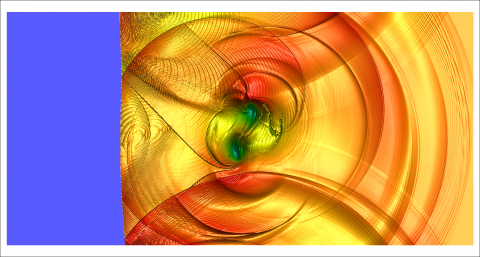CI2 – Inviscid Strong Vortex-Shock Wave Interaction

Test case leader:
Chongam Kim
Contact:
chongam snu [dot] ac [dot] kr (chongam[at]snu[dot]ac[dot]kr)
snu [dot] ac [dot] kr (chongam[at]snu[dot]ac[dot]kr)
info cenaero [dot] be (info[at]cenaero[dot]be)
cenaero [dot] be (info[at]cenaero[dot]be)
Summary:
This case is designed to verify that a scheme can capture complex physical phenomena resulting from the interaction between a strong vortex and a shock wave. This is a two-dimensional unsteady inviscid flow including multiple shock discontinuities. When the strong vortex and the strong shock wave encounter, considerable distortion of shock structure occurs, followed by the generation of linear and non-linear waves propagating onto the downstream flow fields. Two distinctive physical phenomena can be observed in this problem. First, the strong vortex is split into two separate vortical structure due to the compression effects of the shock passage. The post-shock vortical structure depends strongly on the relative strength of the shock and the vortex. Second, cylindrical acoustic wave structure appears on the downstream side of the stationary shock. The sound waves centered on the moving vortex core are partly cut off by the shock wave. As a result, alternating expansion and compression regions are observed.
Andrei Cimpoeru has generously provided a python script that can be used to generate the intial conition for this test case.
Please follow the presentation guidelines when creating your presentation.
UPDATE: July 5 2017: Expression for initial condition rather than a rounded number.
Meshing information:
In the cases of CGNS format, grid files (.cgns) are provided directly. Participants can use them without any pre-processing.
In the cases of GMSH format, GMSH script files (.geo) are provided. Participants can generate each type of meshes by using the GMSH script files and the GMSH program.
In the cases of both "M" and "IT" type meshes, follow the instuctions provided in each GMSH script file to apply a certain meshing algorithm (i.e. Delaunay).
In GMSH script files, participants can modify the variable "nx" to change the grid size.
For example, if you want to generate "RQ100" mesh, insert "100" into "nx" in the "RQ.geo" file.
Physical boundary conditions are set as follows:
. GMSH-type grids:

. CGNS-type grids:

Features and challenges:
Supersonic flow
Inviscid flow